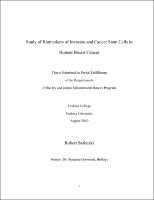Please use this identifier to cite or link to this item:
https://hdl.handle.net/20.500.12202/4205Full metadata record
| DC Field | Value | Language |
|---|---|---|
| dc.contributor.author | Stobezki, Robert | |
| dc.date.accessioned | 2018-11-12T20:18:18Z | |
| dc.date.available | 2018-11-12T20:18:18Z | |
| dc.date.issued | 2010-08 | |
| dc.identifier.uri | https://hdl.handle.net/20.500.12202/4205 | |
| dc.identifier.uri | https://ezproxy.yu.edu/login?url=https://repository.yu.edu/handle/20.500.12202/4205 | |
| dc.description | The file is restricted for YU community access only. | |
| dc.description.abstract | The major challenges faced by breast cancer clinicians are metastasis and drug resistance, which cause a high rate of morbidity and mortality. Tumor cells can detach and give rise to micro metastases, which usually go undetected until they grow. Some of these detached tumor cells remain dormant, but the mechanism that activates the dormant cells is still not understood. We have seen that the microenvironment where the tumor cell resides has an effect on the tumor behavior and that the original genetic makeup is not the only effector. In vivo invasion assay and multiphoton microscopy based intravital imaging has shown that the primary tumor in rodents have a subpopulation of tumor cells that respond to chemoattractants present in the microenvironment produced by perivascular macrophages. These tumor cells are highly motile and do not proliferate, imitating cancer stem cells and are resistant to conventional chemo and radiotherapy. Cell surface biomarkers CD44 and CD24 have been used recently to identify breast cancer stem cells, and it has also been shown that these cancer stem cells can initiate a tumor and cause metastasis. We are quantifying biomarkers of invasion previously identified in our lab and the above mentioned cancer stem cell markers in fine needle aspirates (FNA) from human breast cancer patients. We will correlate this observation with tumor microenvironment of metastasis scores on these patients. This research will give rise to an assay which will identify which of the cancers will metastasize. Clinicians can use this quick, painless, and inexpensive technology to test the potential metastatic nature. This technology can be applied to many different stem cells and invasion markers. | en_US |
| dc.description.sponsorship | Jay and Jeanie Schottenstein Honors Program | en_US |
| dc.language.iso | en_US | en_US |
| dc.publisher | Yeshiva College | en_US |
| dc.rights | Attribution-NonCommercial-NoDerivs 3.0 United States | * |
| dc.rights.uri | http://creativecommons.org/licenses/by-nc-nd/3.0/us/ | * |
| dc.subject | Stem cells --Research. | en_US |
| dc.subject | Stem cells --Therapeutic use. | en_US |
| dc.subject | Cancer cells --Identification. | en_US |
| dc.subject | Biochemical markers. | en_US |
| dc.subject | Breast --Cancer --Chemotherapy. | en_US |
| dc.subject | Drug resistance in cancer cells. | en_US |
| dc.title | Study of Biomarkers of Invasion and Cancer Stem Cells in Human Breast Cancer | en_US |
| dc.type | Thesis | en_US |
| Appears in Collections: | Jay and Jeanie Schottenstein Honors Student Theses | |
Files in This Item:
| File | Description | Size | Format | |
|---|---|---|---|---|
| Robert-Stobezki.pdf Restricted Access | 2.4 MB | Adobe PDF |  View/Open |
This item is licensed under a Creative Commons License

